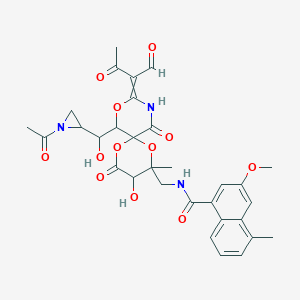Details of the Drug
General Information of Drug (ID: DMZPXRC)
| Drug Name |
Carzinophilin
|
||||||||||||||||||||||
|---|---|---|---|---|---|---|---|---|---|---|---|---|---|---|---|---|---|---|---|---|---|---|---|
| Synonyms |
CARZINOPHILIN; Cardinophyllin; Cardinophillin; Azinomycin; CARZINOPHILIN A; Carzinophyllin; NSC 20088; Antibiotic from Streptomyces Sahachiroi; BRN 5721373; C31H33N3O11; 1403-28-7; Carzinophilin (8CI); AC1MHU1X; Carzinophilin (8CI)(9CI); LS-52587; LS-52588; 11002-20-3; [(1S)-2-[[(1E)-1-[(3R,4R,5S)-3-acetyloxy-4-hydroxy-1-azabicyclo[3.1.0]hexan-2-ylidene]-2-[[(E)-1-hydroxy-3-oxobut-1-en-2-yl]amino]-2-oxoethyl]amino]-1-[(2S)-2-methyloxiran-2-yl]-2-oxoethyl] 3-methoxy-5-methylnaphthalene-1-carboxylate
|
||||||||||||||||||||||
| Indication |
|
||||||||||||||||||||||
| Drug Type |
Small molecular drug
|
||||||||||||||||||||||
| Structure |
 |
||||||||||||||||||||||
| 3D MOL is unavailable | 2D MOL | ||||||||||||||||||||||
| #Ro5 Violations (Lipinski): 2 | Molecular Weight (mw) | 639.6 | |||||||||||||||||||||
| Logarithm of the Partition Coefficient (xlogp) | 0 | ||||||||||||||||||||||
| Rotatable Bond Count (rotbonds) | 8 | ||||||||||||||||||||||
| Hydrogen Bond Donor Count (hbonddonor) | 4 | ||||||||||||||||||||||
| Hydrogen Bond Acceptor Count (hbondacc) | 12 | ||||||||||||||||||||||
| Chemical Identifiers |
|
||||||||||||||||||||||
| Cross-matching ID | |||||||||||||||||||||||
Molecular Interaction Atlas of This Drug
 Drug Therapeutic Target (DTT) |
|
||||||||||||||||||||||||||
|---|---|---|---|---|---|---|---|---|---|---|---|---|---|---|---|---|---|---|---|---|---|---|---|---|---|---|---|
| Molecular Interaction Atlas (MIA) | |||||||||||||||||||||||||||
